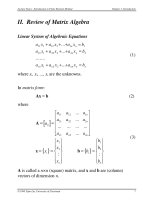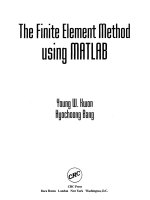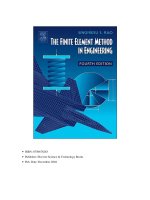Lecture Notes: Introduction to Finite Element Method (Chapter 2)
Bạn đang xem bản rút gọn của tài liệu. Xem và tải ngay bản đầy đủ của tài liệu tại đây (25.75 KB, 6 trang )
Lecture Notes: Introduction to Finite Element Method Chapter 1. Introduction
© 1998 Yijun Liu, University of Cincinnati 7
II. Review of Matrix Algebra
Linear System of Algebraic Equations
a x a x a x b
a x a x a x b
a x a x a x b
n n
n n
n n nn n n
11 1 12 2 1 1
21 1 22 2 2 2
1 1 2 2
+ + + =
+ + + =
+ + + =
...
...
.......
...
(1)
where x
1
, x
2
, ..., x
n
are the unknowns.
In matrix form:
Ax b=
(2)
where
[ ]
{ } { }
A
x b
= =
= =
= =
a
a a a
a a a
a a a
x
x
x
x
b
b
b
b
ij
n
n
n n nn
i
n
i
n
11 12 1
21 22 2
1 2
1
2
1
2
...
...
... ... ... ...
...
: :
(3)
A is called a n×n (square) matrix, and x and b are (column)
vectors of dimension n.
Lecture Notes: Introduction to Finite Element Method Chapter 1. Introduction
© 1998 Yijun Liu, University of Cincinnati 8
Row and Column Vectors
[ ]
v w= =
v v v
w
w
w
1 2 3
1
2
3
Matrix Addition and Subtraction
For two matrices A and B, both of the same size (m×n), the
addition and subtraction are defined by
C A B
D A B
= + = +
= − = −
with
with
c a b
d a b
ij ij ij
ij ij ij
Scalar Multiplication
[ ]
λ λA = a
ij
Matrix Multiplication
For two matrices A (of size l×m) and B (of size m×n), the
product of AB is defined by
C AB= =
∑
=
with c a b
ij ik
k
m
kj
1
where i = 1, 2, ..., l; j = 1, 2, ..., n.
Note that, in general,
AB BA≠
, but ( ) ( )AB C A BC=
(associative).
Lecture Notes: Introduction to Finite Element Method Chapter 1. Introduction
© 1998 Yijun Liu, University of Cincinnati 9
Transpose of a Matrix
If A = [a
ij
], then the transpose of A is
[ ]
A
T
ji
a=
Notice that ( )AB B A
T T T
= .
Symmetric Matrix
A square (n×n) matrix A is called symmetric, if
A A=
T
or
a a
ij ji
=
Unit (Identity) Matrix
I =
1 0 0
0 1 0
0 0 1
...
...
... ... ... ...
...
Note that AI = A, Ix = x.
Determinant of a Matrix
The determinant of square matrix A is a scalar number
denoted by det A or |A|. For 2×2 and 3×3 matrices, their
determinants are given by
det
a b
c d
ad bc
= −
Lecture Notes: Introduction to Finite Element Method Chapter 1. Introduction
© 1998 Yijun Liu, University of Cincinnati 10
and
det
a a a
a a a
a a a
a a a a a a a a a
a a a a a a a a a
11 12 13
21 22 23
31 32 33
11 22 33 12 23 31 21 32 13
13 22 31 12 21 33 23 32 11
= + +
− − −
Singular Matrix
A square matrix A is singular if det A = 0, which indicates
problems in the systems (nonunique solutions, degeneracy, etc.)
Matrix Inversion
For a square and nonsingular matrix A (
detA ≠ 0
), its
inverse A
-1
is constructed in such a way that
AA A A I
− −
= =
1 1
The cofactor matrix C of matrix A is defined by
C M
ij
i j
ij
= −
+
( )1
where M
ij
is the determinant of the smaller matrix obtained by
eliminating the ith row and jth column of A.
Thus, the inverse of A can be determined by
A
A
C
−
=
1
1
det
T
We can show that ( )AB B A
− − −
=
1 1 1
.
Lecture Notes: Introduction to Finite Element Method Chapter 1. Introduction
© 1998 Yijun Liu, University of Cincinnati 11
Examples:
(1)
a b
c d
ad bc
d b
c a
=
−
−
−
−1
1
( )
Checking,
a b
c d
a b
c d
ad bc
d b
c a
a b
c d
=
−
−
−
=
−1
1
1 0
0 1
( )
(2)
1 1 0
1 2 1
0 1 2
1
4 2 1
3 2 1
2 2 1
1 1 1
3 2 1
2 2 1
1 1 1
1
−
− −
−
=
− −
=
−
( )
T
Checking,
1 1 0
1 2 1
0 1 2
3 2 1
2 2 1
1 1 1
1 0 0
0 1 0
0 0 1
−
− −
−
=
If det A = 0 (i.e., A is singular), then A
-1
does not exist!
The solution of the linear system of equations (Eq.(1)) can be
expressed as (assuming the coefficient matrix A is nonsingular)
x A b=
−1
Thus, the main task in solving a linear system of equations is to
found the inverse of the coefficient matrix.









